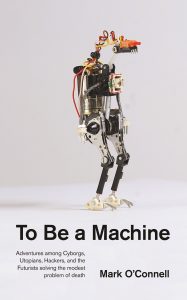
…a movement predicated on the conviction that we can and should use technology to control the future evolution of our species. It is their belief that we can and should eradicate aging as a cause of death; that we can and should use technology to augment our bodies and our minds; that we can and should merge with machines, remaking ourselves, finally, in the image of our own higher ideals.’ I don’t know whether to be excited or scared.
Transhumanism and all of its wild acolytes is the subject of Mark O’Connell’s 2017 book, To Be a Machine – Adventures Among Cyborgs, Utopians, Hackers, and the Futurists Solving the Modest Problem of Death.
While To Be a Machine is centered on the transhumanism movement, the book is offers a broader critique of a Silicon Valley culture that sees itself on the verge of escape velocity. A culture of blind technooptimism where all of life seems divided into problems and solutions — solutions that always take the form of some application of technology. Humans and all of our issues, O’Connell shows, can be fixed with just the right app and our upgraded versions can be better than before.
Transhumanism as a lens on our growing appetite for immortality
To Be a Machine challenges our relationship with technology and exposes how dependent we have become on the glowing stuff around us. O’Connell’s narrative journey through a strangely techno-optimistic landscape exposes our growing appetite for immortality. Even death is just a problem to be solved.
Typically missing from the public conversation surrounding humans and exponential technological advancement is any insight about what it says about us. And to question the inescapable trajectory of technological advancement is to be publicly branded a luddite. But O’Connell opens the door for a conversation about motives and end points. He never tries to solve the problems of technology’s breakneck acceleration but rather offers the questions for the rest of us to ponder. He’s not anti-technology but exposes the absurd elements of where we see technology taking us. More importantly, he explores why.
O’Connell’s lens on technology is, ultimately, an exploration of the human condition. Drawing analogies to Christianity and Buddhism, he shows that transhumanism fits in the human sequence of resisting the inevitable. Fixation on our immortality, it seems, is an ageless preoccupation.
To Be a Machine as one of this generation’s most important books
O’Connell is a beautiful writer. This is one of the few books where I found myself reading paragraphs over and over for their sheer beauty. Language is his medium. The last book that forced this type of obsessive behavior in me was the Emperor of All Maladies.
I would call To Be a Machine one of the most important books I have read in over a decade. This book should be read and discussed as a means of offering critical insight into our relationship with technology and where we see ourselves headed as humans. Besides winning the Wellcome Book Prize, O’Connell was a speaker at DotMed 2017.
Links to Amazon are affiliate links.